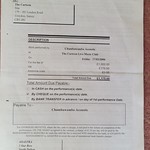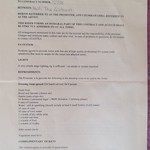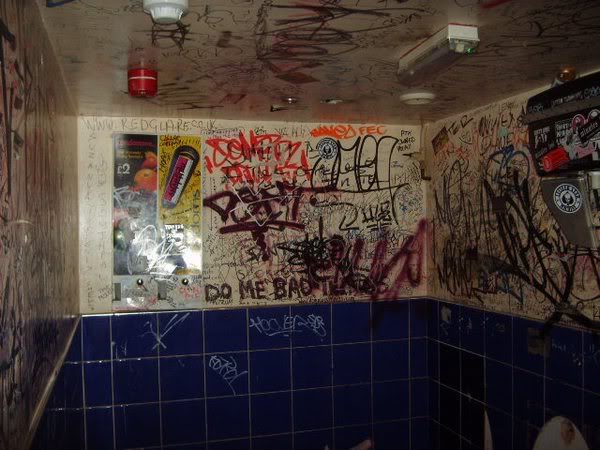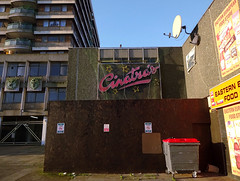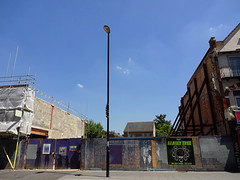The long, low block of shop units at 171–183 London Road is currently rather sparsely occupied; at the time of writing, fewer than half of the units are in use. Moreover, the block itself has only been in existence since the 1960s. I’m therefore going to cover all seven shop units in one article; first, I’ll discuss numbers 171–175, then number 177, and finally numbers 179–183.
Early 1960s: Construction
The grey, utilitarian appearance of this block presents quite a contrast to the ornately moulded and balconied façade of Royal Parade across the road, and offers a strong clue to its era of construction. It was built in the 1960s, as part of a mixed-use development that saw the final sweeping-away of all traces of the land’s original occupant: a grand house with extensive grounds that at their peak stretched from the modern-day Chatfield Road all the way up to Sumner Road.
While a substantial proportion of the grounds were built on during the 1890s, the house itself survived until the early 1960s, when it was demolished to make way for the new development. This consisted of 64 flats (Zodiac Court), office accommodation (Zodiac House), a petrol garage and car showroom, a large ballroom, a small shop tucked underneath the offices, and seven more shops, running along London Road in front of the ballroom space.[1]
Part 1: 171–175 London Road
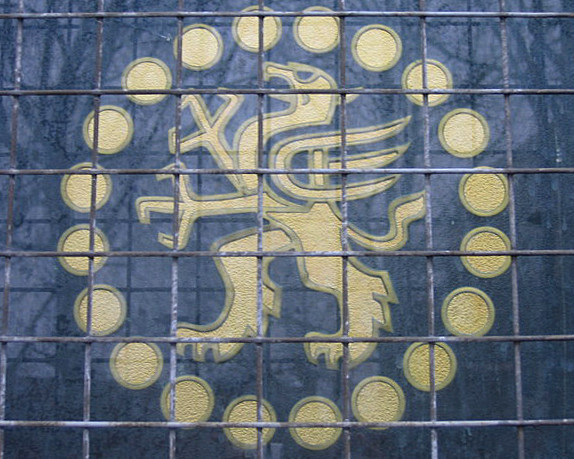
1960s–2000s at 171–175: Midland Bank and Forward Trust
Although the seven units were intended as shops, one of the earliest occupants was in fact a bank. Midland Bank was in place by the end of 1966, occupying the two southernmost units: numbers 171 and 173.[2]
This was not the first Midland branch on London Road; there was another of over fifty years’ standing just up the road at number 238, and yet another further up, well beyond Thornton Heath Pond, at number 1050. By August 1967, however, the branch at number 238 had closed; presumably it had been the company’s intention all along to transfer its West Croydon operations from the small corner unit at 238 to the rather larger and newer premises at 171–173.[3]
In May 1968, the Croydon branch of the Forward Trust Finance Company moved its offices from Wellesley Road to 175 London Road, next to the Midland Bank’s double unit. This was no coincidence; although formed as an independent hire purchase company in Birmingham in 1928, Forward Trust was acquired by Midland in 1958, a decade before its arrival on London Road. As a subsidiary of Midland, it offered “credit facilities for motor trade customers, marine dealers and contractors’ plant clients”. Croydon Council granted planning consent only on the condition that “A shopfront [...] shall be provided and maintained” in order “to protect the visual amenities of the area”.[4]
Around 1976, Forward Trust moved to the High Street, and Midland expanded into the now-vacant space.[5] The bank now occupied nearly half the block (and, as described below, it was shortly joined by the United Bank Ltd next door, meaning that during the late 1970s four of the seven units were used for banking). Midland remained here until around 2003, with a rebranding to HSBC along the way, but then departed.[6]
2000s–2010s at 171–175: Anadolu Kıraathanesi, Pêri Community & Social Centre, and Hard Jazz Café
On 17 August 2004, Croydon Council granted planning permission for a “community & social centre for the Kurdish community with advisory & internet cafe facility” at 171–175 London Road. By July 2008, numbers 171–173 were occupied by this centre — Anadolu Kıraathanesi — while number 175 had become an “Anatolian hair salon”.[7]
By November 2011, the hair salon was no more, and number 175 was in the hands of local businessman Ajazz Mir. Having previously run a shisha cafe on Derby Road which closed down after the introduction of the indoor smoking ban, when Ajazz noticed number 175 up to let he immediately saw “the potential [...] for the open space in front [...] to do the shisha, which has become quite popular with people who want a different kind of entertainment or evening out”.[8]
Hard Jazz Café opened in November 2011, offering hot drinks, juices, smoothies, milkshakes, cakes, waffles, soup, and panini with fillings such as chicken seekh kebab, roast beef, and sweet & sour vegetables. However, it closed again less than a year later.[9]
By March 2012, Anadolu Kıraathanesi had been renamed to Pêri Community & Social Centre. At some point it also gave up the right-hand unit, retrenching to number 171 alone. It continued to operate until at least June 2014, but closed down by early 2015.[10]
2010s at 173: Cut & Stitch and Saira Boutique
Meanwhile, number 173 had been taken over by Cut & Stitch/Saira Boutique, a clothes shop and tailors which had previously been housed at the back of Al-Waqt Electrical at number 177. This was in place by August 2012, but closed down again some time between May 2014 and March 2015.[11]
2010s at 171–173: Cash & Carry Beds, Needlez, Anatolia, and Eastern European Food Store
In early 2015, numbers 171 and 173 reopened as a branch of Cash & Carry Beds, which had been operating on Derby Road since at least November 2010 (and which still operates there today). This proved less successful than the original location, however. The company soon reduced its operations to just the single unit at number 171, and departed London Road completely by mid-2016; it never even got around to installing a proper sign.[12]
The halving in size of Cash & Carry Beds left number 173 vacant, but by the end of 2015 it had been reoccupied by Anatolia, a small Turkish coffee shop which at the time of writing sells coffee but no food, and operates more as a private club than as an actual cafe. The black-boarded and almost windowless frontage gives almost no clues as to what lies within, and a stern sign warns that entrance is restricted to “Members Only”.[13]
Following the departure of Cash & Carry Beds, number 171 briefly saw service as a mobile phone and computer repair shop, internet cafe, and dressmaker/tailor called Croydon Mobiles And Computer Repairs. This opened around June 2016, but by October of that year had been replaced by Needlez, a tailors offering “stitching & alterations”. Needlez in turn closed down some time between March and July 2017, and was replaced in October of that year by a grocery shop known simply as Eastern European Food Store.[14]
2010s at 175: Clearance Outlet and Adom
Number 175, previously home to Hard Jazz Café, had also moved into the clothing business. By May 2014, it was a “clearance outlet” offering “exciting prices” on “clothing & accessories”; however, by July 2014 it too was gone, and had been replaced by Adom hairdressers. Adom remains there today, offering services including hair extensions, cornrows, Ghana braid, ear piercing, and eyelash extensions.[15]
Part 2: 177 London Road
1960s–1970s at 177: Interstate Personnel Bureau and Protim Services Ltd
While numbers 171–175 had seen a stable start to their life, with very little change before the start of the 21st century, number 177 had rather more turnover in its early years. In the late 1960s it was occupied by an employment agency known as Interstate Personnel Bureau, which remained here until the early 1970s.
The replacement for Interstate Personnel Bureau was Protim Services Ltd, offering “timber preserving products” and damp proofing. Although the company’s initial planning application claimed that it wanted to use the unit as both offices and showroom, the 50 square feet allotted to the latter use amounted, in the words of a Croydon Council officer, to “little more than a window display, as it would only be 3–4 ft in depth”. However, this was no impediment, as the Council determined that this was not in fact a change of use, and Protim was in place by March 1973. It lasted only a handful of years, and was gone by 1977.
1970s–1980s at 177: United Bank Ltd
Next to arrive at number 177 was United Bank Ltd, an international commercial bank. Originally founded in Pakistan in 1959, it opened a London office at 19 Curzon Street in 1963 and a Croydon office here on London Road around 1977. Having been nationalised in 1972, it would remain in the hands of the Pakistani government for the next 40 years. It remained on London Road for a rather shorter period, however, and by May 1983 had departed Croydon for good.[16]
1980s at 177: Metyclean Ltd
United Bank was replaced by Metyclean Ltd, dealing in typewriters and other office equipment including “hand held computers”. These “computers”, made by Hewlett Packard, were not the more general, multi-purpose sort of computers like today’s tablets or smartphones, but rather programmable calculators which came with accessories such as thermal printers and magnetic card readers. Even this was perhaps too futuristic for the people of West Croydon, as Metyclean remained here only a couple of years and had moved to George Street by mid-1985.[17]
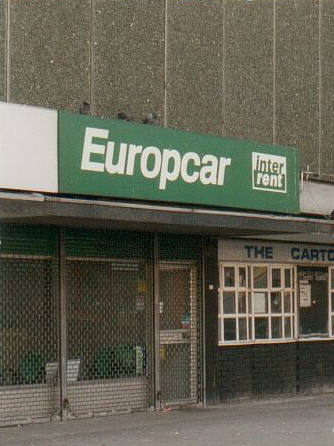
1990s–2000s at 177: Europcar
It’s unclear what number 177 was used for during the second half of the 1980s. A planning application to turn it into “‘The Real McCoy’ fast food take away/burger restaurant” appears to have come to nothing. Another planning application suggests the presence of an estate agent around 1988, but doesn’t give its name.[19]
By early 1992, however, the car hire firm which had previously been in the small shop unit directly underneath Zodiac House had moved to this rather more prominent location.
Originally known as Godfrey Davis, this firm became Godfrey Davis Europcar after a 1981 takeover by the French firm Europcar, and finally dropped the “Godfrey Davis” part altogether. It remained at 177 London Road for at least a decade, but was gone by mid-2009.[20]
c.2010–2017 at 177: Al-Waqt Electrical and Broadway 4
By November 2010, Europcar had been replaced by Al-Waqt Electrical, a small business dealing in “electronics, computers, mobiles, watches & accessories”. Like many other small businesses of its type, it also offered Western Union money transfer and Lycamobile calling cards.[21]
Al-Waqt Electrical rebranded to Broadway 4 around the beginning of 2014, but closed down for good in 2017.[22]
Part 3: 179–183 London Road
1960s–1970s at 179–183: Croydon Grill, Larissa, Moss Bros, Ming’s Chinese Restaurant, Curry Garden, and Croydon Tandoori
We now turn to the three units at the north end of the block: numbers 179–183. As described above, their neighbours at numbers 171–177 were all either banks or offices for the first 15 or so years of their lives, but this end of the block was rather more diverse. By April 1968, all three units were occupied: number 179 by the Croydon Grill, 181 by Larissa Boutique, and 183 by Moss Bros menswear.[23]
According to Ron, who worked at the Top Rank Suite from 1967 to 1969, the Croydon Grill was “a sit down and eat” restaurant with “a very modern clean interior”, that was “used often by all [the] Top Rank team”. It served meals such as burger and chips, among other things. Ron’s favourite meal there was tinned ravioli and chips, followed by “a slice of their delicious (a large) apple pie which was delivered fresh every day”. It was open by August 1967, and remained until around 1972.[24]
Meanwhile, all was change at number 181. Larissa was very swiftly replaced by Ming’s Chinese Restaurant, which in turn became an Indian restaurant called Curry Garden — all of this by mid-1971. Curry Garden became Croydon Tandoori around 1973 (possibly a change of management, possibly just a rebrand); this remained until around 1977.[25]
Moss Bros was the most persistent of the three original inhabitants, remaining at number 183 until the late 1970s before moving to Norfolk House, Wellesley Road. It was similarly persistent in its new home; in fact, it’s still there today.[26]
1976: Arrival of The Cartoon
Probably the most memorable occupant of the entire block — and, among a certain segment of the population, the most well-loved — was The Cartoon. This pub and live music venue was opened in 1976 by Stuart Wilder, who had previously been landlord at the Rising Sun a little further up the road. Stuart was a customer at the previous rather short-lived occupant of number 179 — the Old Vine wine bar, run by Arthur Schlereth — and seems to have considered it just the right place to buy when he “fancied running a place of his own”.[27]
According to Dave Holman, who later became the manager of The Cartoon, it “was really known in those days as a wine bar and probably one of the first of its kind in the area” as well as being “among the first places to serve ‘real ale’” with “barrels of Royal Oak on the bar”. Indeed, it was included in a guide published by the Campaign for Real Ale in the early 1980s, Real Ale in South London, with the listed ales including Dorchester Bitter, Dorset Original IPA, and Royal Oak from the Eldridge Pope brewery, as well as Tiger and Old Original from Everards.[28]
The Cartoon originally occupied just the single unit at number 179, but a year or so later it expanded into the next-door unit at number 181 that had been left vacant by the departure of Croydon Tandoori. The division between the two units was “knocked through”, ensuring that customers “could still see the stage from almost anywhere along the bar”.[29]
According to Chris Groom, whose book Rockin’ and Around Croydon documents the history of rock, folk, blues, and jazz in the local area between 1960 and 1980, the live music side of things was almost accidental:[30]
It was originally a pub/wine bar catering for the working population of Broad Green and West Croydon and the live music only started to appear when a few occasional singers performed on a Friday and Saturday night.
As these impromptu sessions became popular, Dave Holman was employed as bar manager with a particular mission to increase and improve the live music side of the business. With a new venue for groups to play, word quickly spread amongst local musicians and bands who emerged to fill every available slot and pretty soon The Cartoon began their seven nights-a-week music policy, making it a haven for live music fans right across South East London.
1979: Audition night at The Cartoon
Paul Wright, whose band The Transistors played at one of The Cartoon’s audition nights in 1979, remembers the venue well:[31]
Punk Rock exploded during 1977 and broke down a number of social barriers. Groups like the Sex Pistols and The Clash showed that you no longer had to be a great musician to play in a band, anyone could do it. Kids began to pick-up guitars, learn a few chords and write their own songs. [...]
I joined local punk band Sid & The Suspects in 1978 as the lead singer. We played a gig at a youth club in Beckenham but the band didn’t last very long, and I joined The Transistors in 1979. We were four teenagers who wrote our own songs and practiced regularly. We played a few gigs at youth clubs and school discos and gradually built-up a small local following. Around this time someone suggested to us that The Transistors should play a gig at The Cartoon pub in Croydon.
The Cartoon had been at 179–183 London Road since 1976 and had a good reputation as a live music venue. After making some enquiries we were told to give the manager a demo tape of our songs. He would listen to our music and if he liked it we would be invited to play at The Cartoon on audition night. We handed the manager a cassette of our songs and we were invited to play on an audition night in 1979. Bands didn’t get paid for audition nights but there was always the chance of being asked back to play on a regular basis, and be paid for it.
We enjoyed the thrill of playing at The Cartoon, our first gig at a proper music venue. The Transistors were a New Wave band belting out angry songs, but by 1979 the music scene was changing. There was a Ska revival led by The Specials and Madness, and the emergence of synthesiser bands who went on to dominate the pop charts in the early 1980s. We were already looking dated, and perhaps not surprisingly we weren’t asked back.
1980s: Further expansion despite objections from local residents
The Cartoon expanded further in the late 1980s, taking over number 183 for a total of three of the seven shop units. This move was somewhat unpopular with certain of the local residents, one of whom wrote to Croydon Council pleading with them to “For god’s sake think of the residents and say NO!”:[32]
Since buying property in this area in 1980 I have had to put up with Motor Bikes being parked all over the pavement while the said establishment is open [...] these premises have a license until 12.00 Midnight whereupon I then have to listen to all of these Bikes being revved up until they finally vacate the area.
For the last few years the said premises have had a live Band playing so-called ‘Rock’ music every night, plus Saturday and Sunday lunchtimes [...] I am fed up living opposite a bloody open air festival of pure noise.
Despite this passionate objection, Croydon Council granted permission for the expansion on 22 September 1988.
Early 1990s: Three bands for £2
The Cartoon continued to have a reputation for live music throughout the 1990s. Simon Landmine, who lived in Purley from the age of 13 to 18, spent “pretty much every Wednesday evening there for a year or more at the turn of the 90s”:[34]
Wednesday nights were “three bands for £2” nights [£4.17 in 2016 prices] put on by Phil and Ian (who later put on the Raw Rock rock night on Saturdays at The Stairway, above the Blue Anchor). Usually at least one local band (to guarantee a crowd of local punters). I started going because I knew people in some of the bands (via school and youth club — Croydon had a thriving local rock scene in the late 80s), and stopped when I left Croydon to go to university. Local scene bands included Hazard, 17 Crash, The Sluts, A&D (Armed & Dangerous), Leviathan, and Flight 16 (who actually managed to score a record deal with Sony and a couple of US and European tours before self-combusting as one might expect [...]).
There were bands on other nights too, but they tended to cost more, so [our visits on those nights] weren't such a regular thing, unless it was a band we actually wanted to see.
Door staff were drawn from a cast of famously intimidating bikers — I have vague memories of the names Big Mick, and possibly Bill, although that might have been the guy who lived at one end of the bar — so there was often a custom Harley or two pulled up next to the wall outside the door. In the summer there were somewhat hopeful picnic tables outside. Oh, and obviously it smelt of cigarette smoke, as did any clothes you wore there.
Drummer Robert Lowe, whose band Abbfinoosty made regular appearances at The Cartoon around the same time, also has “many happy memories” from “the late 80’s/early 90’s”:[35]
It was always packed, always loud, always hot [...] As a small venue it was one of those places you were up close and personal with the crowd. [...] We played there as support to a few semi famous bands and soon became the headline Saturday night act. We built up a good local following there, we got paid well and it became a regular thing for us.
I always remember the sound on stage being pretty good for a small venue, although some of the people who watched us play there told me we made the building shake. We worked with a couple of resident sound engineers, one of whom in particular loved us and worked a light show around our music.
Chris White, who “ran the music side of the venue for about two years” around 1991–1993, recalled “an eclectic mix of people” as well as varied styles of music:[36]
We averaged three sell out nights a week, and had a very vibrant scene going on. Monday nights were an open night and audition night, and was free to get in. Tuesday was Indie night. Wednesday was the famous Raw Rock, and this was the rock night run by two other promoters, Ian Askew and Phill Kingdon. Thursday was soul night, and then Friday and Saturday were a mixture of the various headline bands that we would slowly rotate on a three of [sic] four month basis. And then Sunday lunch would be Blues bands! [...]
I think the one constant set of memories that I fondly return to would be working the lights for the bands, and between me and the musicians we would hypnotize the audience into complete silence, and when the song finished, the explosion of applause. That's when you know you've done a good job.
Late 1990s: A brief diversion into chrome and cocktails
A brief experiment around the end of the 1990s saw The Cartoon become The Cool Room, with a “new look” including “neon, chrome, cocktails and bottled lager”. However, according to Chris Groom:[37]
[...] the booking policy tried too hard to cater for every taste; comedy nights & club nights equalled less live music and consequently fewer punters. [...] the new system failed to work and it was a huge relief when Noel [Nevin] arrived on the scene; the old name reappeared over the door, along with the original cartoon back on the wall and the seven nights-a-week hard rock, rhythm and blues policy was reinstated.”
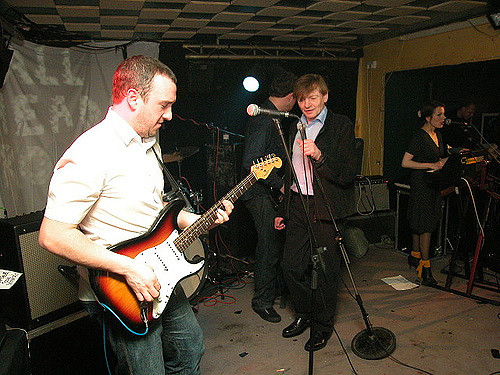
2006: The Fall and the end
The Cartoon scored something of a coup in 2006 — the year of its 30th anniversary — as it booked The Fall for a four-night run from 12–15 March.[39]
The national newspapers were somewhat dismissive of the venue, describing it as being “in a grim Seventies municipal block on the London Road”, with the band being “obscured (depending where you are) by pillars or speaker cabinets”.[40]
Fan reactions were more enthusiastic. One described the third night as “A storming set” in which “Mark stayed on stage for the entire time” (not always a given with The Fall) and the “band were as tight as I've ever seen them.” Another, who was there on the fourth and final night, described it as “the best Fall gig I have seen. They were so together and focussed [...] Everything was played fairly straight and with amost [sic] no mucking about but at a real intensity”.[41]
This appears to have been part of something of a relaunch of the venue; according to a post on the Urban75 forums, around the start of the year a new owner had “bought The cartoon, [...] tried to revamp it up a bit, and [...] booked The Fall for 4 nights in March (as well as Chas n Dave and Chumbawamba).”[42]
However, the final end for The Cartoon was already in sight. Towards the end of the year, “news filtered through” that it “was to close its doors for the last time”, and by early December, its website bore the mournful message that “The Cartoon has unfortunately had to close.” As Robert Lowe told me a decade later, “It was a tragic shame [...] as the local crowd fragmented and there are not many unique and dedicated music venues around like this.”[43]
2009–2010: The Club
The premises remained vacant for three years after The Cartoon closed, but in November 2009 the façade was “painted over” in preparation to become a “dance club”.[44] The new owner, former Radio 1 DJ Chris Goldfinger, told the Croydon Advertiser that the new venue would be named simply “The Club”, because it was “going to be the club in Croydon to go to”. A diverse range of music was planned: pop on Wednesdays; R & B, jazz, and soul on Thursdays; 70s and 80s disco on Fridays; and reggae on Saturdays. The original stage from the Cartoon days would be left intact, offering the possibility that live music could be reintroduced in the future.[45]
Despite the intention for “Security [...] to be paramount”, with “a metal detector arch at the entrance doorway and [...] a team of security staff operating on the doors and inside the club itself”, The Club was forced to close just a year after opening, as Croydon Council suspended its licence “following a request from the police Licensing Unit”. Police told the Croydon Advertiser that there had been “a number of incidents of violent disorder”, and although owner Chris claimed that there had only been “some small incidents like people being bottled”, on 29 December 2010 the council’s licensing committee agreed to revoke The Club’s licence permanently.[46]
2012–c.2014: Tabú Lounge
Over the next couple of years, The Club remained in Chris’s hands but also remained closed to the general public, though several one-off events were hosted there. These included a “Nut & Bolt” Valentine’s party on Saturday 13 February 2012, with advertisements specifying a “red & white” dress code and promising that “Every king will recieve [sic] a bolt, every queen will recieve a nut and the right connection will recieve a cash price [sic] on the night”.[47] The fact that all these events passed “without incident” may have been a factor in Croydon Council’s decision in September 2012 to allow another attempt at operating a club on the premises.[48]
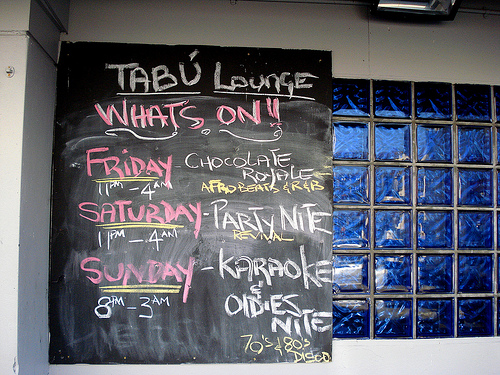
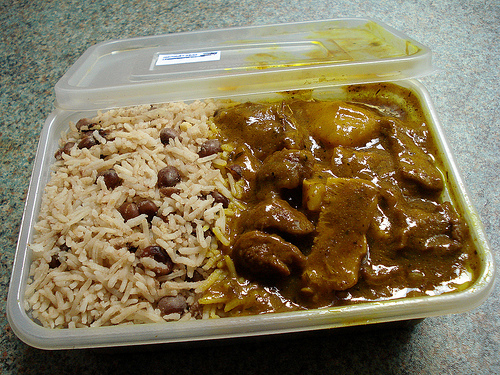
Tabú Lounge, an “over-25s venue” aiming to attract “respectable and law-abiding clientele” was granted permission to open on the conditions that its membership scheme was up and running within 12 months, ID scanners were used at all times, and all drinks were served in plastic containers.[49]
The new club opened in November 2012, and was initially overseen by a manager, Everton Daniels. In March 2014, however, Chris was “pleasantly surprised” to find that Croydon Council were willing to transfer day-to-day running to him, despite a police submission claiming that this would “significantly increase the risk of crime and disorder” and describing Tabú Lounge as a “dying business with outstanding rent arrears”.[50]
By mid-2015, clubbers were warning that “We’re about to lose another club [...] the Tabu Lounge is going shame!!! Another black venue as gone…” It’s not clear exactly when it closed, but by Spring 2016 the entrance doors were blocked off and the forecourt covered with construction materials for the conversion of Vistec House next door. It remains to be seen whether the premises will ever host live music again.[51]
Thanks to: Alistair Dey; Boak & Bailey; Brian Mortimer; Chris White; clayts450; Dave Brown; Ewan Munro; lesbub; Paul Wright; Robert Lowe; Ron (@onthesettee); Roy Hughes; Simon Landmine; Sven Petersen; the Planning Technical Support Team at Croydon Council; the staff, volunteers, and patrons at the Museum of Croydon; and my beta-readers bob and Fred. Non-Croydon phone books consulted via Ancestry.co.uk. Monetary conversions performed using the Bank of England inflation calculator (prices < £100 given to the nearest penny, prices from £100 to < £100,000 to the nearest pound, prices from £100,000 to < £1 million to the nearest £1,000, prices from £1 million to < £100 million to the nearest £100,000, prices ≥ £100 million to the nearest million).
Footnotes and references
- See part 3 of my mini-series on Zodiac Court for more information on the demolition and rebuilding.
- The first appearance of Midland Bank on this part of London Road is in the December 1966 Outer London: North East Surrey phone book, at number 173 (it is absent from the June 1966 Croydon edition). The single number doesn’t mean it only occupied one unit; phone books of this era generally only gave one street number, rather than a range. The company was granted permission to use “Shop units Nos. 6 and 7, Nos. 179–181 [sic] London Road, Croydon, as bank premises” on 19 March 1965 (viewed on microfiche at Croydon Council offices, ref 65/251). Another planning application (ref 68/20/509, for the small single shop unit underneath Zodiac House) includes a plan showing that the block of seven were numbered from north to south, so numbers 6 and 7 would have been the two southernmost; this plan also confirms the occupier of these two units as “Midland Bank Ltd”. Moreover, on 20 June 1966, Midland Bank was granted permission for display of an “Illum: [Illuminated] Fascia Sign” at 171–173 London Road.
- The December 1966 Outer London: North East Surrey phone book lists Midland Bank at 173, 238, and 1050 London Road. The branch at number 238 is first documented as the London, City & Midland Bank Ltd in Ward’s 1910 directory (I’ll discuss the various incarnations of the company in my article on that address). The final phone book appearance of the branch at number 238 is in the August 1967 Croydon edition.
- Information on acquisition of Forward Trust by Midland is taken from Handbook on the History of European Banks, edited by Manfred Pohl (page 1154, viewed online at Google Books). Date and place of Forward Trust’s founding are taken from the subheading of “Your Communities: Forward Trust Group colleagues gather together”, Birmingham Mail, 1 November 2012. Information on date of move and previous location of offices, as well as quotation regarding services offered, is taken from a small article on page 6 of the 10 May 1968 Croydon Advertiser. This article refers to “the bank’s new East Croydon branch”, but this is clearly a mistake and should be “West Croydon”. Quotation regarding planning permission is taken from the relevant planning records (ref 67/20/1713).
- Croydon phone books list Forward Trust at 175 London Road up to and including the January 1976 edition, and at 58 High Street from July 1977 onwards. On 14 December 1976, Midland Bank was granted planning permission for “Alterations to shopfront to No. 175 London Road” including “two new accesses to the adjoining Midland Bank” and “The signs relating to Forward Trust [...] to be removed” (ref 76/20/1894). The three-shopfront bank can be seen in a photograph in the collection at the Museum of Croydon, taken on 31 January 1997 (ref PH/06/550–552), and also appears in plans included in other planning applications (refs 93/2319/A and 97/1621/A).
- According to Handbook on the History of European Banks (page 1224), Midland “became a wholly-owned member of the HSBC Group” in July 1992. Croydon phone books list Midland Bank up to and including July 1999, and HSBC thereafter. They use the address 172 London Road rather than 171 — a surprisingly persistent mistake. (172 London Road doesn’t actually exist - as explained in my article on renumbering, there are gaps in the numbering of this road at most of the side streets. On the west side at the junction with Kidderminster Road, it jumps straight from number 162 to number 182.) They also continue to list it here until at least 2009–2010, when it clearly couldn’t have been, given Google Street View evidence that Anadolu Kıraathanesi was here by July 2008. Moreover, a planning application granted to Doneagles Restaurants on 17 August 2004 states that the premises were only used as a bank until 2003 (ref 04/02566/P).
- Planning application ref 04/02566/P. Information on situation as of July 2008 taken from Google Street View.
- Quotation is taken from Eastlondonlines video. The video also makes it clear that the cafe was just in the single unit of number 175, even though its sign also extended across the frontage of number 173. Information on the Derby Road shisha cafe is taken from “Will hookahs be illegal?”, Croydon Guardian, 11 April 2007. According to Google Street View, the Derby Road one closed down by July 2008.
- Opening date taken from Eastlondonlines article. Information on food and drinks is taken from a sign I saw outside in March 2012. Information on closure is also from personal observation; as of August 2012 the premises were vacant, with a sign in the window offering “cafe equipment for sale”. A member of staff at Al-Waqt Electrical next door at number 177 told me that the cafe had moved to a new location further up London Road near Thornton Heath Pond, but I never managed to track it down.
- Name as of March 2012 and closure by early 2015 are both from personal observation. Status as of June 2014 (including the fact that it was only in number 171 at this point) is according to Google Street View imagery.
- All information from personal observation. I can’t remember where I found out about about them having previously been at the back of Al-Waqt Electrical; I noted the information down at the time but didn’t note the source. See also my photo of their A-board in August 2012.
- All information from personal observation, aside from the status of Cash & Carry Beds as of November 2010, which is taken from Google Street View imagery.
- All from personal observation. When I popped in to have a look in October 2016, the staff member I spoke to told me it had been open for about a year at that point, that it was called Anatolia, and that it did coffee but no food. The “Members Only” sign appeared some time between then and October 2017. As of October 2017 I’ve not personally seen it open for a while, but according to staff at Eastern European Food Store next door, it generally only opens in the afternoons, and it’s usually morning when I’m passing.
- All information from personal observation. Quotation regarding Needlez is from the shopfront as of October 2016.
Again, this is all from personal observation. The quotations are from the frontage as of May 2014 (see photo reproduced here), and the services on offer at Adom are taken from a sign I saw outside in July 2014.
- United Bank Ltd, “Comml [Commercial] Bank”, is listed at 177 London Road in phone books from the July 1977 Croydon edition to the November 1982 Outer London: North East Surrey edition inclusive, while later editions instead list Metyclean Ltd. According to a planning application granted on 7 December 1976, its head office was at 29 Mincing Lane, EC3 (ref A76/211). An article on page 2 of the 18 March 1983 Times (“Suspended sentence for banker”) confirms that the United Bank on Mincing Lane was the one “owned by the Government of Pakistan”. Information on the founding and nationalisation of United Bank Ltd is taken from the entry for Agha Hasan Abedi (the bank’s founder) in Historical Dictionary of Pakistan by Shahid Javed Burki, viewed online via Google Books. Date and location of the first London office are taken from an advert on page 12 of the 30 August 1963 Times. According to an International Monetary Fund working paper published in 2005, the bank was partially re-privatised in 2002, with “51 percent sold to consortium of Abu Dhabi and Pakistani expatriate investors” (“State-Owned Banks, Stability, Privatization, and Growth: Practical Policy Decisions in a World Without Empirical Proof”, Michael Andrews, 1 January 2005, p38, available as a PDF on the IMF website).
- Metyclean Ltd, “Typws, Bsns Eqpt — The Office Shop” is listed at 177 London Road in the May 1983 and October 1984 Caterham/Reigate phone books, and at 60 George Street in the 1985 Croydon edition. It’s entirely absent from the 1987 Croydon edition. According to an advert on page 607 of the 3 March 1983 New Scientist (viewed via Google Books, from which it has since sadly been removed), as of that date Metyclean Ltd had branches at 92 Victoria Street, SW1; 137 Strand, WC2; 177 London Road, Croydon; and 100 Rosemount Viaduct, Aberdeen; and it sold “hand held computers” from Hewlett Packard including the HP 41C and HP 41CV as well as HP 41 peripherals such as card readers, printers, and cassette drives. More information on the HP 41C series can be found on Wikipedia. According to a planning application deposited on 20 August 1985 (ref 85/2150/P), 177 London Road was vacant (“Void Property”) at that point but had been an “office equipment shop until June ’85”.
- Although the Flickr page for this photo states that it was “Taken on August 19, 2009”, this is just the date it was scanned. Brian tells me that the photo was actually taken “in 1993 or early 1994” (via email, 17 November 2014).
- Planning application ref 88/1690/P has a handwritten list of the occupants of the seven shops; the middle one is “E Agents”.
- Europcar is listed at 177 London Road in Croydon phone books from February 1992 to 2003–2004 inclusive. Editions after this give only a non-geographical (0870) phone number. Google Street View imagery from July 2009 shows number 177 as vacant and to let. For more information on this company and its predecessor Godfrey Davis, see part 3 of my mini-series on the Zodiac Court development.
- Al-Waqt Electrical is shown at 177 London Road in Google Street View imagery from November 2010. Quotation and other information taken from the shopfront as of March 2012 (see photo in main article).
- All from personal observation. The name change took place between December 2013 and April 2014, and the closure between March and September 2017. I’m not 100% certain that the shop kept the same ownership over the name change, but it certainly didn’t make many (if any) changes in what it did.
- All three appear in the April 1968 Outer London: North East Surrey phone book. The Croydon Grill and Larissa also appear in the August 1967 Croydon edition.
- The Croydon Grill is listed in Croydon phone books from August 1967 to February 1972 inclusive. The only Croydon Grill in the March 1973 Croydon edition is at 40 High Street (and the High Street one didn’t appear in 1972). This could mean that the proprietors moved from 179 London Road to 40 High Street, or it could be a coincidence — “Croydon Grill” is a fairly generic name. Quotations and information on meals are taken from a Twitter DM conversation with Ron, 13–16 February 2019.
- Phone books list Larissa Boutique in August 1967 (Croydon edition) and April 1968 (Outer London: North East Surrey edition); Ming’s Chinese Restaurant in September 1968 (Croydon) and September 1969 (North East Surrey); Curry Garden in August 1970 (Croydon), July 1971 (North East Surrey), and February 1972 (Croydon), and Croydon Tandoori Restaurant from March 1973 (Croydon) to July 1977 (Croydon) inclusive.
- Moss Bros is listed on London Road in phone books from the April 1968 Outer London: North East Surrey edition to the July 1977 Croydon edition inclusive. The November 1978 Bromley/Orpington edition instead lists it at “Norfolk Ho, 17 George St”, which I think must be a misinterpretation of 17 Norfolk House, Wellesley Road — 17 Norfolk House, which is the current premises of Moss Bross, is at the corner of Wellesley Road and George Street, while 17 George Street is nowhere near (it’s the address of the George pub, near George Street tram stop). From personal observation, Moss Bros has been at its current premises since at least 2007.
Date of opening, information about Stuart Wilder being the landlord at the Rising Sun, and quotation about running his own place are taken from Rockin’ and Around Croydon, Chris Groom, page 210 (interview with Dave Holman). Information on the name and owner of the previous wine bar comes from Sue Dryden, who worked there in 1975 and commented on this article (25 January 2020) to say “Prior to the venue being The Cartoon [...] it was actually called The Old Vine [...] It was owned by a German called Arthur and I worked there in 1975. (The hottest summer I can remember.) Stuart Wilder from The Rising Sun was a customer who then bought it and expanded the premises.” A planning application (ref 76/20/898) deposited by “A Schlereth” on 26 May 1976 confirms the name “The Old Vine”. The January 1976 Croydon phone book lists “The Old Wine Bar” at number 179, which must be a typo. The February 1975 North East Surrey edition lists neither an Old Vine nor an Old Wine.
According to an article on page 6 of the 22 November 1985 Croydon Advertiser (“Cartoon capers”), Stuart was a collector of cartoons, which was likely the reason for choosing this name for his new venue. The article also explains the origin of the cartoons that covered the walls. American-born cartoonist Kevin Kallaugher, who drew cartoons for several London newspapers under the name “Kal”, saw the venue in 1979 while in Croydon to visit the Home Office, and “was naturally intrigued by the name and went inside”. “There he met Mr Wilder, who collected cartoons, and in no time he covered a blank wall with cariacatures of some of the locals.” Another cartooning session in 1985, organised by Kal, saw various “Fleet Street cartoonists” including Richard Cole of the Times and Steve Bell of the Guardian drawing cariacatures of “Margaret Thatcher, Ronald Reagan and other well-known figures” as well as Stuart himself. The article ends by stating that “All the walls in the pub have now been covered after the latest cartooning capers.” Simon Landmine, who as mentioned in the main article was a regular at The Cartoon around the start of the 1990s, tells me that there were several different “generations” of cartoons on the walls.
Quotations taken from Rockin’ and Around Croydon (interview with Dave Holman, page 210). In line with Dave’s comment about it initially being a wine bar, the July 1977 Croydon phone book lists “The Cartoon, Wine Bar” at number 179.
Information from Real Ale in South London provided by Alistair Dey, who discusses the Forest Hill section of the guide in “A recent history of Forest Hill pubs” on the Forest Hill Society website. The wording in the guide is somewhat confusing; the beer listing reads “COURAGE: Directors. ELDRIDGE POPE: Dorchester Bitter; DORSET: Original IPA and Royal Oak; EVERARDS: Tiger and Old Original.” However, I think (and beer historians Boak & Bailey agree with me) that there has been some confusion between note-taker and typer-up, and “DORSET: Original IPA” should read “Dorset Original IPA”.
- Quotations are taken from Rockin’ and Around Croydon, page 210, which also implies that the “knocking through” was complete by around 1978.
- “Sketches from the Cartoon”, accessed 11 October 2017. The whole article is well worth reading.
- Via email, 11 January 2015, reproduced by permission. Dave Holman also describes the audition nights on pages 210–211 of Rockin’ and Around Croydon: “Word got round the circuit pretty quickly that the Cartoon was beginning to expand as a live music venue and we began to get far more [demo] tapes than we could handle, so we started to run audition nights, where we would have three or sometimes four new bands playing about half an hour each to try them out. It was good free entertainment for the pub regulars on an ‘off-peak’ week night and was obviously a better way of seeing how well a band could perform live”.
- Handwritten letter included in the records of planning application 88/1690/P.
- As noted in an earlier footnote, although the Flickr page for this photo states that it was “Taken on August 19, 2009”, this is just the date it was scanned; Brian tells me that the photo was actually taken “in 1993 or early 1994” (via email, 17 November 2014).
- Via email, 24 and 25 March 2017. Monetary conversion made using 1990 as base year. For another memory of The Cartoon around this time, see “Poppers and Opal Fruits”, Jack Pandemian, Smoke: a london peculiar.
- Via email, 16 October 2017.
- Via email, 21 October 2017.
- Quotations all taken from “Sketches from the Cartoon”, which places the closure “sometime around the end of 1997”.
- Note that this photo was taken a couple of years after The Cartoon finally closed.
- Gig dates taken from listing on page 55 of the 8 March 2006 Croydon Guardian.
- “The Fall, The Cartoon Club, Croydon”, Tim Cumming, The Independent, 15 March 2006, accessed 14 October 2017.
- Colinham, 15 March 2006 , and Living Leg End, 16 March 2006, both on The Fall online forum, accessed 14 October 2017.
- A listing on page 66 of the 15 March Croydon Guardian confirms that Chumbawamba were booked to play there on 17 March; a fan comment on the Crystal Palace Football Club forums described this as “a slightly cut-down Chumbawamba playing a great little accoustic [sic] type set”. (A similar listing on page 57 of the 1 March 2006 edition shows Chas ‘n’ Dave booked for 2 March.)
- First two quotations are from “Sketches from the Cartoon”; third quotation is from The Cartoon Website, archived by the Internet Archive on 5 December 2006; and fourth quotation is from Robert Lowe, via email, 16 October 2017. According to a photo on Flickr, the last night the venue was open was 19 November.
- Quotations taken from a comment by John Lees on his Flickr photo of the old Cartoon façade: “[...] the facade remained for ages as a reminder of times gone by - it got painted over this week as it is to become some ‘dance club’ next month.” At the time of writing, the Flickr website makes it difficult to see the date a comment was made, but according to the Flickr API this comment was made on Sunday 29 November 2009.
- “Famous venue is set for re-opening”, Croydon Advertiser, 13 November 2009, viewed as a clipping in the “London Road — West Croydon” roads file at the Museum of Croydon.
- First quotation taken from “Famous venue is set for re-opening”, Croydon Advertiser, 13 November 2009. Other quotations taken from “Club ‘at heart’ of underworld is closed down”, Croydon Advertiser, 31 December 2010, front page.
- Information and quotations regarding the “Nut & Bolt” party are taken from an advert in the programme for the September 2012 West Croydon Carnival of Cultures.
- Quotation taken from “‘Violent’ club could re-open”, Croydon Guardian, 5 September 2012, page 9, which notes that “10 one-off events have been held at the site, all passing without incident”.
- Quotations and information taken from “Nightclub blighted by violence is to re-open”, Croydon Advertiser, 14 September 2012, page 33.
- Opening date of Tabú Lounge is from personal observation. According to a report from Croydon Council’s Licensing Sub-Committee (PDF) (dated 26 March 2014), the original holder of the premises licence granted in September 2012 was Chantel Palmer and the original designated premises supervisor was Everton Fitzroy Daniels. This report also provides further details of the police claim that Tabú Lounge was a “dying business” (see pages 30–31 of the PDF). Quotations taken from “DJ club boss may sue cops”, Croydon Guardian, 2 April 2014, page 7.
- Quotation taken from “Sad news all ravers”, Porky’s Wine Bar blog, 19 July 2015 (accessed 18 October 2017). Situation as of Spring 2016 is from personal observation (see photo at end of main article).
